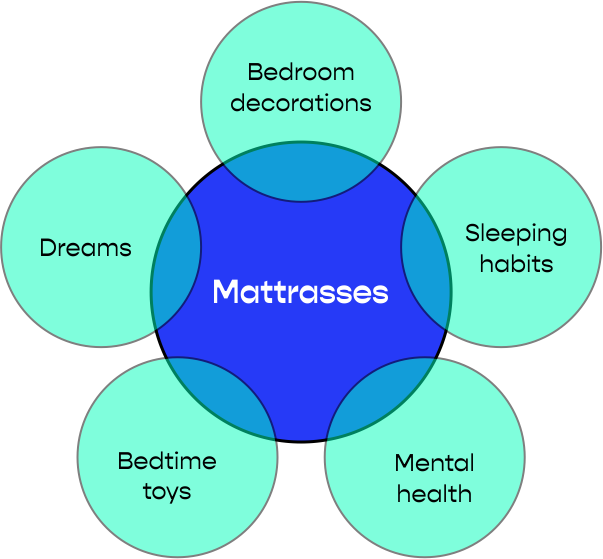When developing ideas for a PR campaign, one of the first decisions you need to make is whether your content will be topical or tangential. This is crucial for both data-led campaigns and storytelling purposes.
Topical content
Topical content, sometimes referred to as on-brand content, is directly related to your business or niche. It’s fairly straightforward: If you sell mattresses, then everything directly related to them (types of mattresses, manufacturing details, size variations, etc.) is considered topical content.
Topical content is directly related to your business core or service offerings
This is a great type of content to publish on your own blog if you want to generate more keywords, attract organic traffic or educate your customers about your products.
But that content won’t earn you media coverage or backlinks. Even if you conduct a survey on the most popular mattress types and sizes by age group and support this information with stunning visuals, this isn’t something that journalists want to write about…unless you’re Apple or Tesla.
Examples of a topical content for mattresses:
- The most popular mattresses fillers in America – report
- Orthopedic mattresses improve sleep of eldery people – study
- Things you should know when buying a mattress for your newborn
Let’s agree that these topics won’t spark the interest of journalists. It does not mean, however, that there is no demand for that kind of content – there is a large audience who are interested in learning more about mattresses on selected topics, and the best place for that type of content would be your website or blog. But for media coverage it’s just not newsworthy.
So how do you secure media coverage and acquire backlinks if you sell mattresses? That’s where tangential content comes into play.
Tangential content
Though tangential content is not directly related to your business’s core, it’s still relevant to your niche in one way or another. Most importantly for us, it can be aligned with your business in the interest of a PR campaign.
Tangential content is not directly related to your business’s core or service offerings, but is still relevant to your niche in one way or another.
Referring back to our earlier example, what’s related to mattresses? Let’s start with the obvious: beds, sleep, dreams. What else? Bedroom decor, sleeping habits, bedroom accessories. The list goes on. Separately, these topics are too broad to draw the interest of the public and journalists. But they provide us with so much more diversity that we are now able to choose the best topic for a digital PR campaign—a trending and newsworthy one for which we can get data points.

The examples from the diagram above are not made up. These are actual news coverage from top tier news and magazines:
- Sleep and Mental Health – Harvard Health Publishing – Harvard Health
- 10 Bedroom Plants to Improve Your Sleep – Treehugger
- The forgotten medieval habit of ‘two sleeps’ – BBC Future
- 6 Best Bedtime Teas That Help You Sleep in 2022 – Healthline
- We Are Addicted to Screens. Here’s How It’s Wreaking Havoc On Our Health – Inc.com
- One in three Brits still sleep with their favourite teddy bear, a survey finds – The Sun
- ‘Sleep should be prescribed’: what those late nights out could be costing you | Sleep – The Guardian
All of these publications normally cover a few stats from initial research, while the source contains bigger stats and insights on wider questions not covered in those publications. But the goal is achieved – backlink is earned and brand is mentioned.
Any report, survey or other type of data campaign you create should consist of many different stats, insights and facts. Also, journalists will not copy-paste your whole campaign. Instead, they might write an article based on 1-2 numbers that they deem interesting. Or they might incorporate your newly published stats into a completely different story they were covering when you reached out to them.

For example, a survey on “Nation-X’s sleeping habits in big cities” might include data on which apps help us fall asleep or wake up. That would appeal to tech blogs. How much time do we spend doom-scrolling before falling asleep? That question is more geared toward lifestyle and health magazines.
Choosing the right type of content
If your goal is to earn backlinks, tangential content is your wisest bet. However, topical content is still useful in certain cases. We have already hinted that giants like Apple and Tesla have mostly topical coverage in the news, and that’s because everybody wants to read about their products.
Topical content can be used for trending and evergreen topics. For example, the FinTech niche has been booming over the last few years. If your business falls under that category, there’s a good chance you will earn authoritative coverage with topical content. Many news sites even have a dedicated “FinTech” or “Banking & Payments” section specifically for this type of topical news.

You might not earn as many backlinks as you would with topical content, but perhaps you have other goals in mind:
- Increasing brand awareness
- Landing interviews or features in niche-specific magazines
- Communicating key sales messages
- Etc.
In order to generate a great PR campaign, make sure you understand why you’re running it and set your goals accordingly.